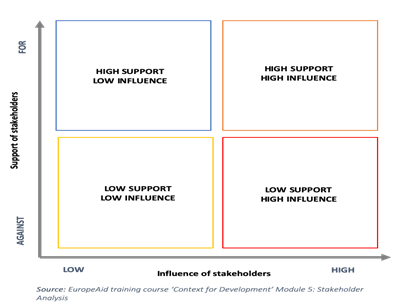
Stakeholders are individuals or groups of people, institutions or companies that may be significantly affected, positively or negatively, by the success or failure of an intervention. A stakeholder analysis comprises a set of techniques based on qualitative data to assess the interest of each stakeholder in the intervention's success/failure and that stakeholder's power (influence) to support or obstruct the intervention.
Stakeholder analysis enables assessment of the relative position of all actors towards an intervention and, together with public policy analysis, facilitates early development of an appropriate partner engagement and communications strategy.
More concretely, stakeholder analysis can be useful in identifying interests, conflicts and risks; opportunities and potentially productive (or obstructive) relationships; appropriate participants; and groups likely to be affected by a change in policy and practice. By providing information on how stakeholders relate to an issue or policy decision, stakeholder analysis can lead to better choices as to how to engage with different stakeholders in order to deliver change.
A key feature of stakeholder analysis is iteration. The positions, interests and influence of stakeholders need to be assessed along the intervention cycle. However, the design phase is critical for identifying the key actors, their positions and capacity, and how engagement can be achieved. A preliminary stakeholder analysis is usually developed as part of a wider process of context analysis at the identification phase.
Stakeholder analysis comprises some major steps.
Starting point: Clarify the reform agenda or intervention objective and outline intended consequences.
Step 1: Identify all relevant stakeholders interested in or potentially affected by the reform or intervention objective(s). Stakeholders can be organised into different categories (e.g. civil society organisations, government, private sector, academia, networks and alliances, etc.). These categories may need to be broken down further into sub-categories to reflect diverging interests and influences. The level of (dis)aggregation will depend on the entry point.
Step 2: Assess stakeholders according to defined criteria, in relation to alternative interventions. This assessment can be made through key informant interviews, surveys, a workshop or a brainstorming exercise, depending on the communication technique deemed most appropriate for each set of stakeholders identified. The most used criteria are 'support' and 'influence', but others can be considered. 'Support' refers to the degree of importance the stakeholder attributes to the intervention. 'Influence' refers to the power the stakeholder may have over the reform/intervention. Representing these positions in a matrix, as shown in Figure 1, enables identification of key stakeholders in relation to the intervention, and helps in determining an engagement strategy is needed.
Figure 1: Stakeholder analysis matrix

Step 3: Map stakeholders. Stakeholders are then represented in a map (Figure 2) as a means of visualising the relation of the stakeholders not only towards the intervention, but also to each other – a critical element when building consensus around an intervention. Mapping can be used to assess institutions, as well as entire governance sectors and political reform proposals. Different structures and graphic effects (size, colour, lines) can be used to represent stakeholder power, interest and relations as determined from the previous steps.
Figure 2: Example of stakeholder visualization

Source: EuropeAid training course 'Context for Development' Module 5: Stakeholder Analysis.
Next step: Establish a communication and engagement strategy. Based on the stakeholder assessment and mapping, appropriate communication modalities should be developed to frame subsequent policy dialogue and initiate the development of stakeholder engagement strategies. The entire process, if properly conducted, will help reinforce a sense of ownership among stakeholders, and will improve our understanding of behavioural risks.
Data/information. Preliminary knowledge of the reform/intervention context is critical, as many actors may be informally represented - and therefore difficult to identify. The starting point is often a literature review, followed by data collection methodologies adapted to the stakeholder characteristics.
Time. Stakeholder analysis is a flexible tool; with the support of a specialist with a deep understanding of the context, and a facilitator helping to organise qualitative data collection, it can provide relevant information in a short time. The actual timing will depend on the context – specifically, the accessibility of the stakeholders.
Skills. The literature review can be performed in house, but specific competencies such as facilitation skills or technical expertise may be required to explore and assess stakeholders in more depth. Local expertise can bring added value based on knowledge of local contexts, formal and informal actors and interests which are not always explicit.
Facilities and materials. Depend on data collection method(s) selected.
Financial costs and sources. If external expertise is required, funds should be made available to cover the costs associated with fees (for approximately two to four weeks), travel expenses and logistics. These funds may come from the project itself or through other EC instruments such as a framework contract or a technical cooperation facility.
Tips and tricks
N/A
EU LEARN - Training "Context for Development"
European Commission, 2011. Reference Document Nº6. Toolkit for Capacity development .
European Commission, 2012. Tools and Methodos Series. Concept Paper Nº3. Mappings and Civil Society Assessments .
Deutsche Gesellschaft für internati, GIZ GmbH (Ed.), 2015. Cooperation Management for Practitioners. Managing Social Change with Capacity WORKS. Tool 09 -Map of actors .
Overseas Development Institute, 2006. Mapping Political Context: A Toolkit for Civil Society Organisations.
Department for International Development (DFID), 2003.Tools for Development. Stakeholders' analysis.
The International Bank for Reconstruction and Development / The World Bank, 2007. Tools for institutional, political, and social analysis of policy reform. Stakeholder Analysis.
United States Agency for International Development - USAid. Collaboration Mapping